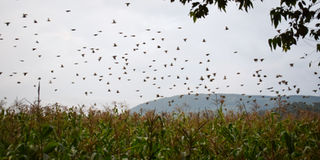The destructive behaviour of quelea birds

Quelea birds fly above a maize plantation in Njoro where they have been sighted.
The invasion of quelea birds in Njoro, Rongai, and Bahati Sub counties poses a significant threat to small grain fields like wheat, sorghum, millet, and rice.
However, their behaviour patterns can help farmers identify and report them for proper control and management.
Ishmael Mganda, a Crop Protection Officer from the Plant Protection and Food Safety Directorate (PP&FSD) under the Ministry of Agriculture & Livestock Development, explains that quelea birds prefer roosting in specific vegetation types such as acacia, reeds, and eucalyptus trees due to the dense shelter these provide.
"These trees and plants offer effective protection from predators and harsh weather conditions," he says.
Quelea birds can travel 30 to 60 kilometres in search of food, making the roosting sites a safe shelter for their survival.

Ishmael Mganda, a Crop Protection Officer inspects crops infested by quelea birds in Njoro.
Mganda notes that a single roosting site can host more than two million birds, which move in small flocks. They leave and return to the roosting site at 6 am and 6 pm, respectively.
"Each bird can consume up to 10 grams of grain every day. While this amount may seem small, a flock of two million can consume up to 20 tonnes of grain in a single day," Mganda reveals.
Dealing with the quelea threat in the field is extremely difficult due to their high migratory nature and rapid breeding.
"It is easier to control them at the roosting site after dark when the birds have settled down for the night," he notes.
He cautions that when weather conditions become favourable, these birds can quickly congregate, and multiply.
It's during these population booms that they cause the most damage to crops.

